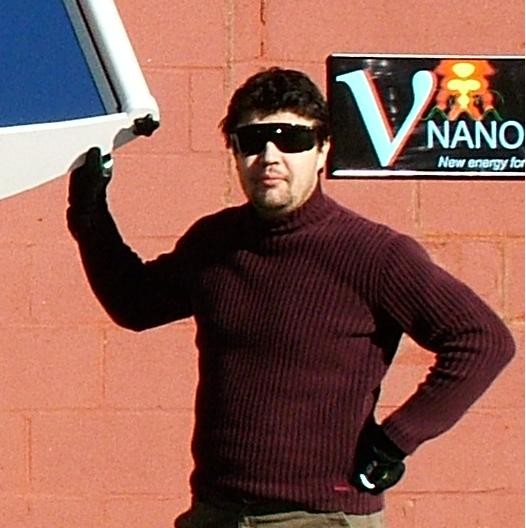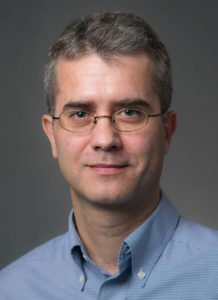 John M. Guerra, P.E., President and C.E.O., founded Nanoptek in 2002, funding the new Company by winning competitive grant awards from N.A.S.A., the U.S. Dept. of Energy, and the Massachusetts Renewable Energy Trust Fund. The technical and business model progress enabled by these grants resulted in turn in a successful Series A raise in December of 2007. The Massachusetts Hydrogen Coalition recognized Guerra in 2008 with their Outstanding Achievement Award for his “work toward a hydrogen economy.”
John M. Guerra, P.E., President and C.E.O., founded Nanoptek in 2002, funding the new Company by winning competitive grant awards from N.A.S.A., the U.S. Dept. of Energy, and the Massachusetts Renewable Energy Trust Fund. The technical and business model progress enabled by these grants resulted in turn in a successful Series A raise in December of 2007. The Massachusetts Hydrogen Coalition recognized Guerra in 2008 with their Outstanding Achievement Award for his “work toward a hydrogen economy.”
Prior to founding Nanoptek, Guerra was V.P. of Technology at Calimetrics Inc. in Alameda CA and Bedford MA, completing a N.I.S.T. Advanced Technology Program in high density optical data storage, as part of an industrial and academic consortium, in part with nano-optical technology he developed at Polaroid as Program Manager of Near-Field Optics Core Technology. Over 23 years at Polaroid Optical Engineering Dept., he developed products for medical, consumer, architectural, and computer imaging, including the award-winning Photon Tunneling Microscope. He also managed the Optical Fabrication and Optical Thin Film Labs.
Guerra has over 50 U.S. and international patents issued and pending. His second patent in 1981 taught the use of zeolites to store solar energy. Guerra has 22 publications in journals including Science. He has given over 20 presentations, with invited talks in U.S., Sweden, Germany, Taiwan, Japan, and China. He was the Optical Society of America’s George Eastman Lecturer in 1991. His work is often cited in texts and patents in nano-optics and near field optics.
Guerra is the recipient of an R&D 100 Award, Photonics’ Circle of Excellence Award, and the Optical Society of America’s Engineering Excellence Award, as well as awards from Polaroid and Cambridge School Volunteers. He is a biographee in Marquis’ Who’s Who in America, Who’s Who in Science, 3rd Edition, (1996-97), and Bowker’s American Men and Women of Science (1998).
 Amol Chandekar, Ph.D., V.P. and Fellow, R&D. Dr. Chandekar developed Nanoptek’s UV-Blue™ photoanode, the “engine” that drives our Lightfuel Solar-Amplified hydrogen generator. This photoanode is unique in its ability to absorb over the entire ultraviolet spectrum and into visible blue light as well, and with we believe to be a record-breaking 25% Solar-to-Hydrogen conversion efficiency .
Amol Chandekar, Ph.D., V.P. and Fellow, R&D. Dr. Chandekar developed Nanoptek’s UV-Blue™ photoanode, the “engine” that drives our Lightfuel Solar-Amplified hydrogen generator. This photoanode is unique in its ability to absorb over the entire ultraviolet spectrum and into visible blue light as well, and with we believe to be a record-breaking 25% Solar-to-Hydrogen conversion efficiency .
Dr. Chandekar joined Nanoptek in 2007 as a post-doc. His many contributions ensured his fast rise to the position of Vice President of R&D and R&D Fellow in 2013. He left Nanoptek for a 2-year tenure with St. Gobain, but in 2015 we were able to win him back to reprise his V.P. of R&D role—only this time, at Lightfuel.
Dr. Chandekar completed his Post Doctoral Fellowship at the University of Massachusetts at Lowell, where he was also awarded his PhD. in Chemistry with Honors. For his undergraduate work, he attended Laxminarayan Institute of Technology, University of Nagpur, India, where he earned his B. Technology in Chemical Engineering.
Dr. Chandekar has 14 publications to his credit, many in the area of nano-scale patterning of materials, as well as 17 patents issued and pending, both U.S. and international. Dr. Chandekar is presently residing in France in order to support our business in the EU.
Technical Advisors:

Luke Thulin, Chief Technical Officer Emeritus, joined Nanoptek in 2004, and was key in the development of Nanoptek and its technology. His accomplishments include development of our Enhanced Sunblock™ and Nanoptek Yellow™ titania pigments and our Visible Light Titania™ photocatalyst that is over twenty times faster in degrading dye-class pollutants than the industry standard. Prior to Nanoptek, Thulin joined Guerra at Calimetrics, where for over two years he developed several inventions in the field of nano-structured optical data storage, and subsequently has two patents and additional patents pending in the U.S. as well as international, and several peer-reviewed publications in this field as well as in photocatalysis. He subsequently obtained his Masters in Photonics Engineering from Boston University. In addition to his many generalist skills that are so critical to a small company, Thulin possesses that rare combination of excellent experimental skills and superb theoretical analysis that continue to benefit us while in his Advisory role.

Andrei Ursache, Ph.D., Senior Staff Emeritus, joined Nanoptek in 2007. As Post Doctoral Researcher at the University of Massachusetts at Amherst, where he obtained his Ph.D. in physics, Dr. Ursache developed capability for in situ EQCM (Electrochemical Quartz Crystal Microbalance), cyclic voltammetry, and impedance spectroscopy of electrochemical cells. His expertise includes fabrication of nanostructured materials and devices by both lithographic nanofabrication and electrochemical processes, as well as advanced electrochemical characterization techniques. Andrei has seven publications and a patent in this field. As Senior Principal Scientist at Nanoptek he was both “researcher par excellence” as well as product development engineer. As such he was key in our completion of product development for the concentrating solar hydrogen generators, specifically in designing and implementing the “command and control” system, as well as the SHG300™ Solar Hydrogen Generator. Andrei designed and supervised construction of his solar surplus net energy home that features both a 6kW PV array and a solar thermal hot water system.
Dmitri Vezenov, Ph.D. Professor Vezenov is in the Chemistry Dept. at  Lehigh University. He received his PhD degree in chemistry from Harvard University while working on the development of a new scanning microscopy technique – chemical force microscopy – to study intermolecular interactions between organic, biological and polymer surfaces at nanometer scale. This work was recognized by the Adhesion Society with the Peebles Award for research in adhesion science. He joined Polaroid Corporation’s media research department to work on optical near field storage systems. He later continued this effort at Calimetrics, and participated in the establishment of Calimetrics’ East Coast facility. He was responsible for the design and testing of the integral near field optics media (INFO), development of new microscopy techniques for characterization of the masters and substrates for the nano-optics, and oversaw the modeling effort in the design of the nano-optical media. As first employee at Nanoptek, Dr. Vezenov was a Principal Investigator on the Phase I NASA SBIR photolysis project, successful completion of which led to the Phase II grant. Dr. Vezenov is a co-author of 14 publications in scientific journals and several patents on nano-optics fabrication and tracking schemes for near-field media.
Lehigh University. He received his PhD degree in chemistry from Harvard University while working on the development of a new scanning microscopy technique – chemical force microscopy – to study intermolecular interactions between organic, biological and polymer surfaces at nanometer scale. This work was recognized by the Adhesion Society with the Peebles Award for research in adhesion science. He joined Polaroid Corporation’s media research department to work on optical near field storage systems. He later continued this effort at Calimetrics, and participated in the establishment of Calimetrics’ East Coast facility. He was responsible for the design and testing of the integral near field optics media (INFO), development of new microscopy techniques for characterization of the masters and substrates for the nano-optics, and oversaw the modeling effort in the design of the nano-optical media. As first employee at Nanoptek, Dr. Vezenov was a Principal Investigator on the Phase I NASA SBIR photolysis project, successful completion of which led to the Phase II grant. Dr. Vezenov is a co-author of 14 publications in scientific journals and several patents on nano-optics fabrication and tracking schemes for near-field media.